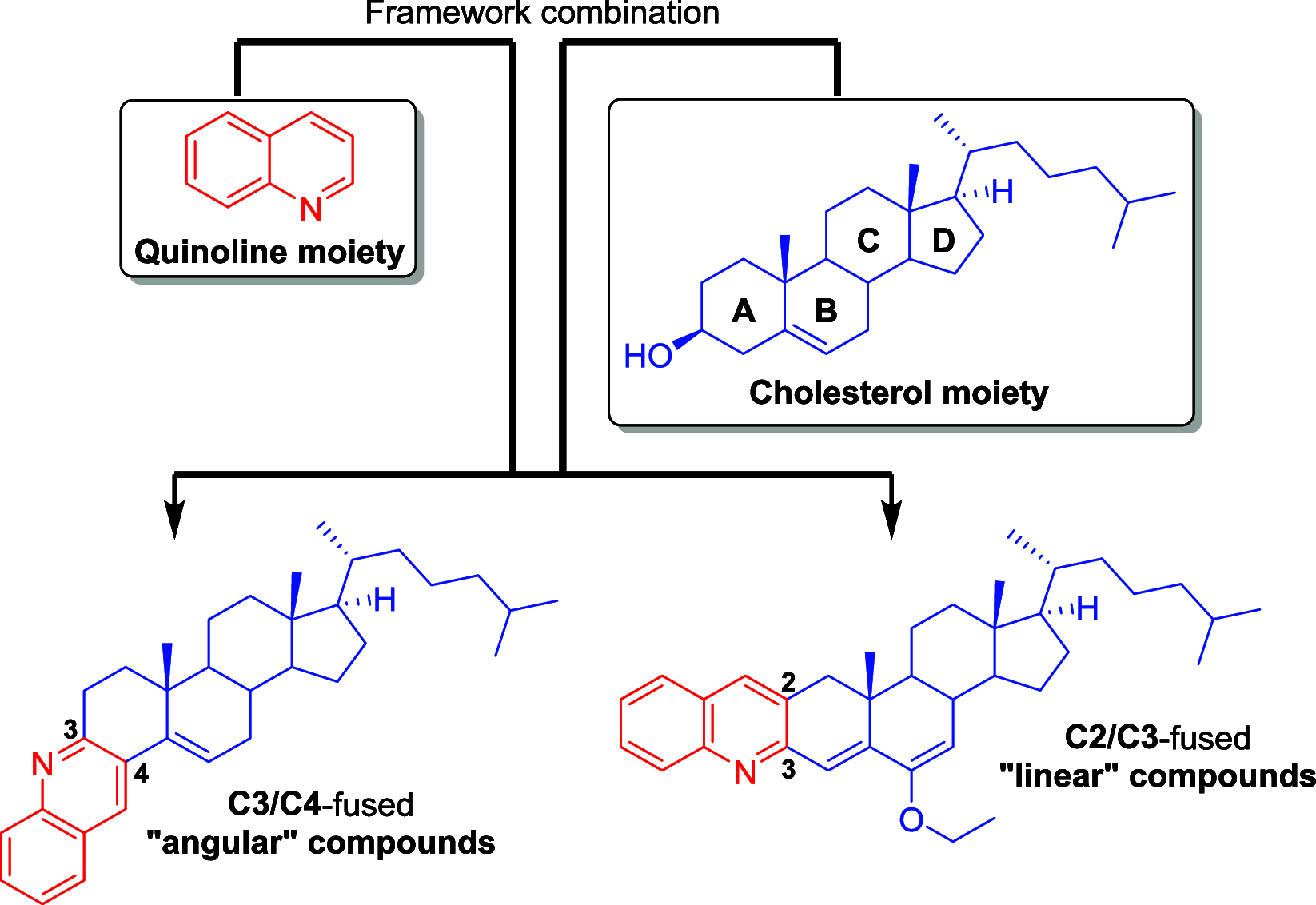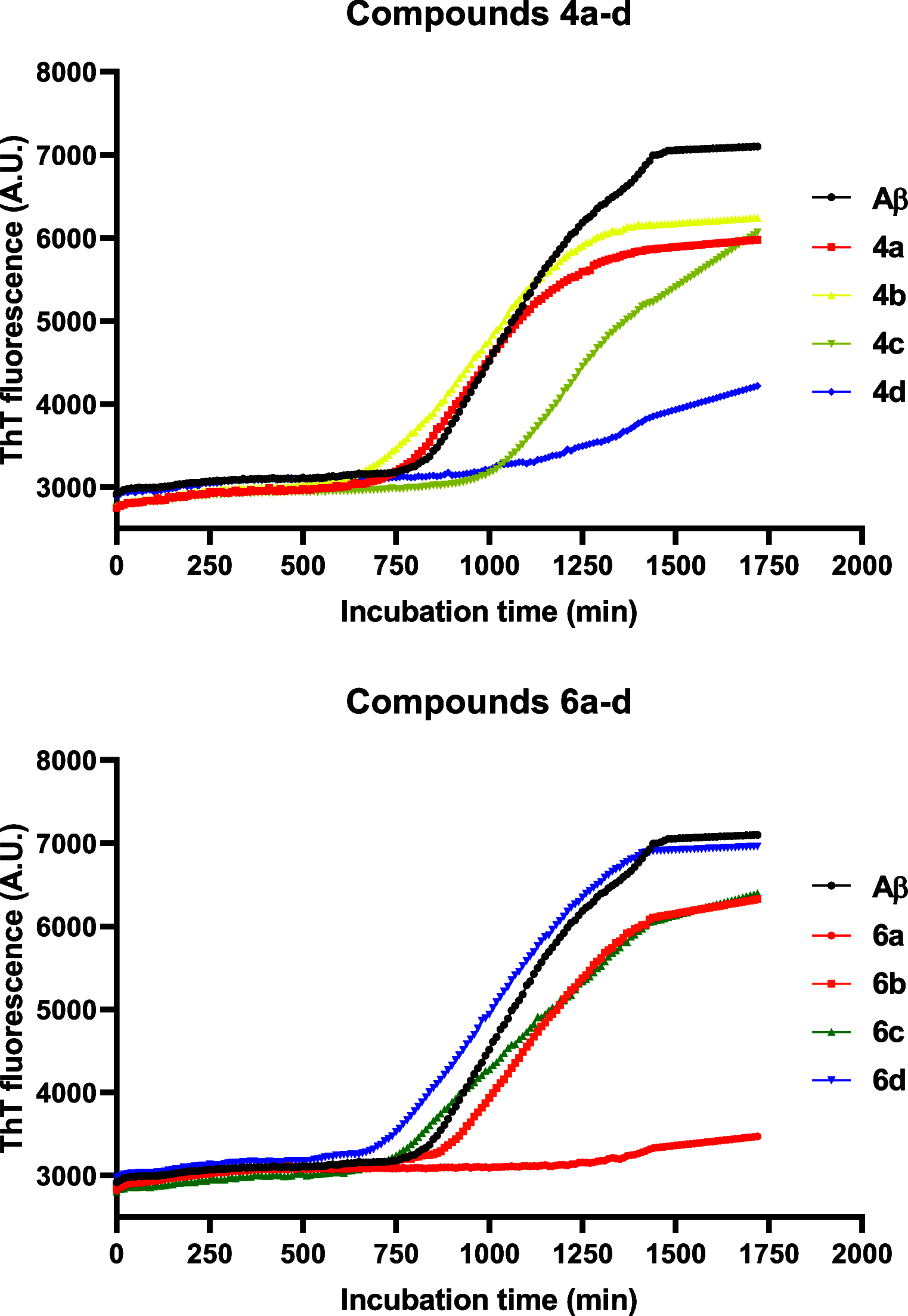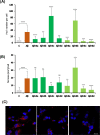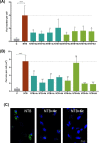Steroid-Quinoline Hybrids for Disruption and Reversion of Protein Aggregation Processes
- PMID: 35300075
- PMCID: PMC8919386
- DOI: 10.1021/acsmedchemlett.1c00604
Steroid-Quinoline Hybrids for Disruption and Reversion of Protein Aggregation Processes
Abstract
Reversing protein aggregation within cells may be an important tool to fight protein-misfolding disorders such as Alzheimer's, Parkinson's, and cardiovascular diseases. Here we report the design and synthesis of a family of steroid-quinoline hybrid compounds based on the framework combination approach. This set of hybrid compounds effectively inhibited Aβ1-42 self-aggregation in vitro by delaying the exponential growth phase and/or reducing the quantity of fibrils in the steady state. Their disaggregation efficacy was further demonstrated against preaggregated Aβ1-42 peptides in cellular assays upon their endocytosis by neuroblastoma cells, as they reverted both the number and the average area of fibrils back to basal levels. The antiaggregation effect of these hybrids was further tested and demonstrated in a cellular model of general protein aggregation expressing a protein aggregation fluorescent sensor. Together, our results show that the new cholesterol-quinoline hybrids possess wide and marked disaggregation capacities and are therefore promising templates for the development of new drugs to deal with conformational disorders.
© 2022 American Chemical Society.
Conflict of interest statement
The authors declare no competing financial interest.
Figures





Similar articles
-
Development of novel 2-aminoalkyl-6-(2-hydroxyphenyl)pyridazin-3(2H)-one derivatives as balanced multifunctional agents against Alzheimer's disease.Eur J Med Chem. 2022 Feb 15;230:114098. doi: 10.1016/j.ejmech.2021.114098. Epub 2022 Jan 5. Eur J Med Chem. 2022. PMID: 35026532
-
Fluorescent Dopamine-Tryptophan Nanocomposites as Dual-Imaging and Antiaggregation Agents: New Generation of Amyloid Theranostics with Trimeric Effects.ACS Appl Mater Interfaces. 2020 Sep 30;12(39):44180-44194. doi: 10.1021/acsami.0c13223. Epub 2020 Sep 15. ACS Appl Mater Interfaces. 2020. PMID: 32870652
-
Novel sarsasapogenin-triazolyl hybrids as potential anti-Alzheimer's agents: Design, synthesis and biological evaluation.Eur J Med Chem. 2018 May 10;151:351-362. doi: 10.1016/j.ejmech.2018.03.082. Epub 2018 Apr 3. Eur J Med Chem. 2018. PMID: 29635167
-
Distinct role of hydration water in protein misfolding and aggregation revealed by fluctuating thermodynamics analysis.Acc Chem Res. 2015 Apr 21;48(4):956-65. doi: 10.1021/acs.accounts.5b00032. Epub 2015 Apr 6. Acc Chem Res. 2015. PMID: 25844814 Review.
-
Protein denaturation and aggregation: Cellular responses to denatured and aggregated proteins.Ann N Y Acad Sci. 2005 Dec;1066:181-221. doi: 10.1196/annals.1363.030. Ann N Y Acad Sci. 2005. PMID: 16533927 Review.
Cited by
-
Medicinal Chemistry in Portugal and Spain: A Strong Iberian Alliance.ACS Med Chem Lett. 2022 Jun 9;13(6):871-872. doi: 10.1021/acsmedchemlett.2c00194. eCollection 2022 Jun 9. ACS Med Chem Lett. 2022. PMID: 35707154 Free PMC article. No abstract available.
-
Influenza A virus propagation requires the activation of the unfolded protein response and the accumulation of insoluble protein aggregates.iScience. 2024 Feb 2;27(3):109100. doi: 10.1016/j.isci.2024.109100. eCollection 2024 Mar 15. iScience. 2024. PMID: 38405606 Free PMC article.
-
Expanding Diversity of Fused Steroid-Quinoline Hybrids by Sequential Amination/Annulation/Aromatization Reactions.J Org Chem. 2025 Mar 21;90(11):3951-3963. doi: 10.1021/acs.joc.4c02981. Epub 2025 Mar 7. J Org Chem. 2025. PMID: 40052426 Free PMC article.
-
Sulfated Polysaccharides as a Fighter with Protein Non-Physiological Aggregation: The Role of Polysaccharide Flexibility and Charge Density.Int J Mol Sci. 2023 Nov 12;24(22):16223. doi: 10.3390/ijms242216223. Int J Mol Sci. 2023. PMID: 38003413 Free PMC article.
-
Drug Discovery Based on Oxygen and Nitrogen (Non-)Heterocyclic Compounds Developed @LAQV-REQUIMTE/Aveiro.Pharmaceuticals (Basel). 2023 Nov 30;16(12):1668. doi: 10.3390/ph16121668. Pharmaceuticals (Basel). 2023. PMID: 38139794 Free PMC article. Review.
References
LinkOut - more resources
Full Text Sources

